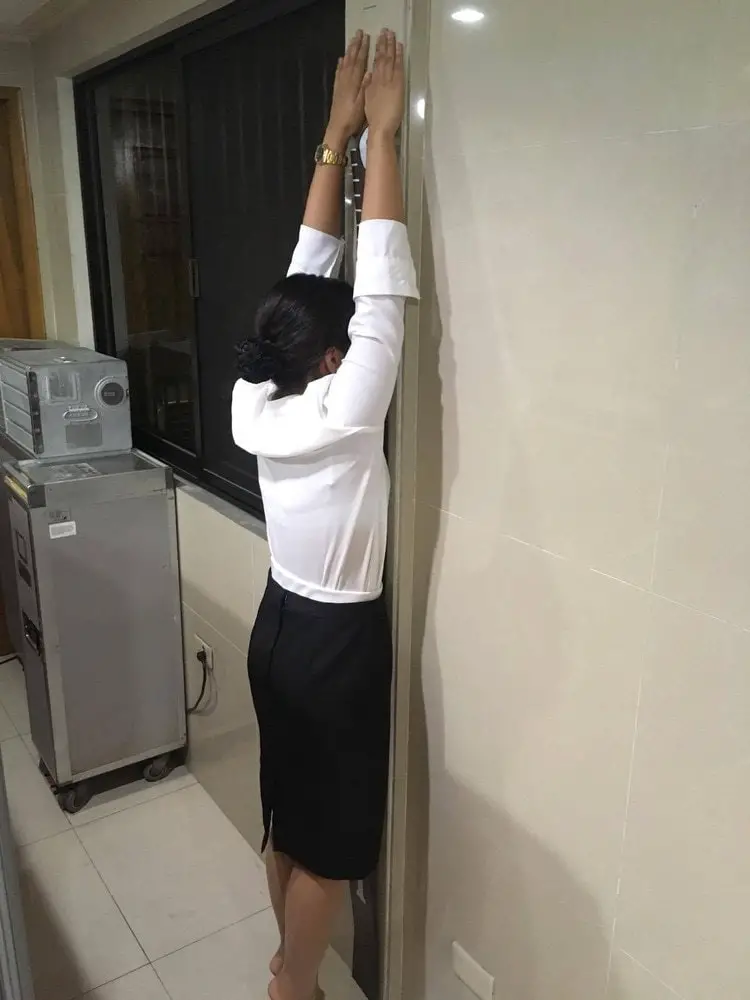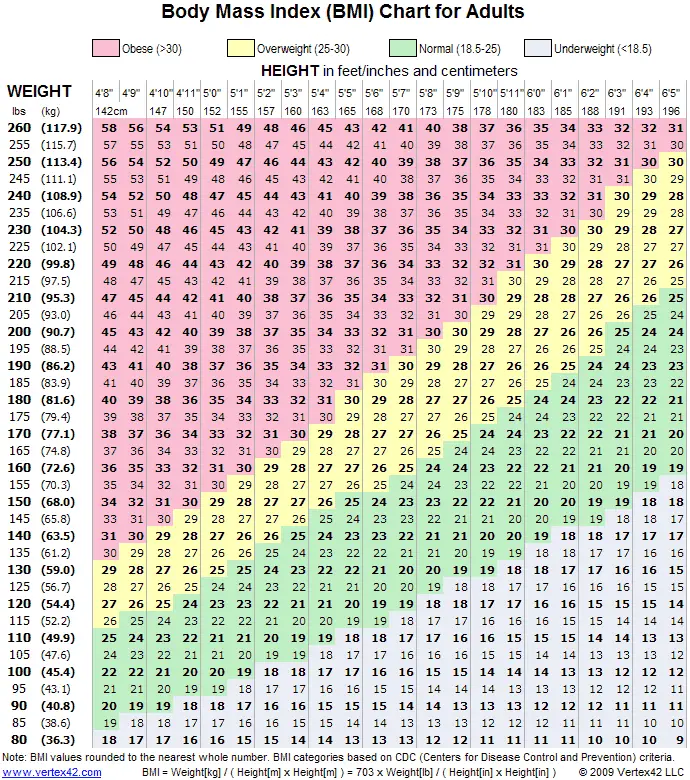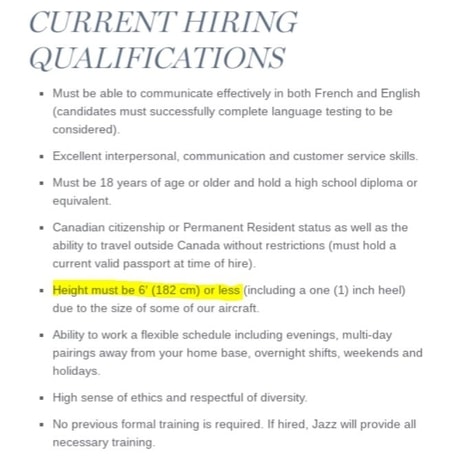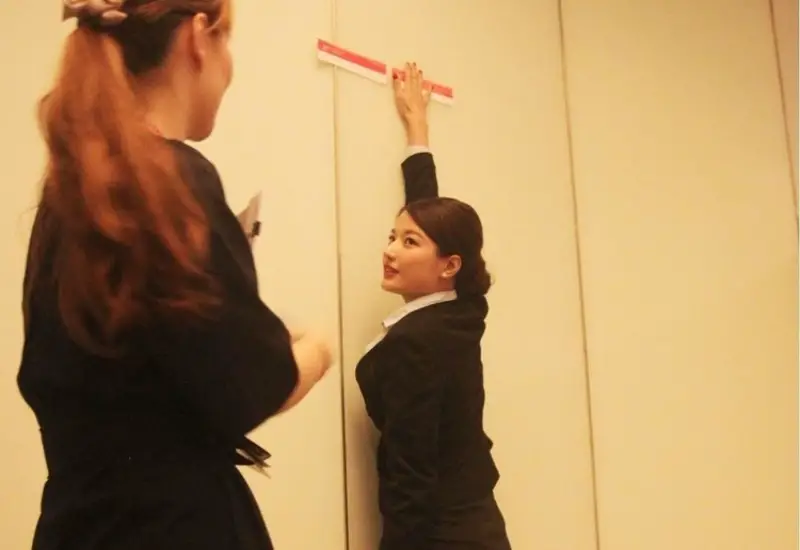There are quite a few requirements that hopeful candidates have to meet in order to become a flight attendant. One of these requirements is height. Many people are unaware that you must be a certain height to work as a flight attendant. This article is intended to help shed light on why this is, how it is measured, and what the common height requirements are for various airlines.
Though the requirements differ slightly from airline to airline, the average minimum height requirement is 157 cm (61.8 inches or 5.1 feet) without shoes. Other airlines measure height using a “reach test” which measures the highest you can reach with your arms above your head. Airlines generally require a minimum reach capacity of 212 cm (83.4 inches, or 6.9 feet).
We have compiled a list of the height requirements from a number of major airlines, but you can also find this information on the airline’s recruiting site.
💡 Key Takeways
- Average Height Requirement: Most airlines require a minimum height of 157 cm (5.1 feet) or a reach capacity of 212 cm (6.9 feet).
- Safety Reasons: Height requirements ensure flight attendants can reach emergency equipment and assist passengers.
- Measurement at Interviews: Airlines strictly measure height during interviews; slight variations may be accommodated.
- Reach-Test Details: The reach-test involves stretching arms above the head, sometimes standing on tiptoes, to reach a specified height.
- Flexibility in Standards: Some airlines have more flexible height standards, especially if candidates possess rare skills or nearly meet requirements.
Table of Contents
Why Is There a Minimum Height Requirement to Become a Flight Attendant?
Though airlines have historically been very selective when it comes to flight attendants’ heights and weights as a way to cultivate a certain brand “image,” discrimination based on height and weight for appearance alone is now illegal in a number of countries.
That said, airlines are able to continue to enforce certain physical requirements, as long as they are for safety reasons. This is because flight attendants’ primary function is to ensure the safety of their passengers.
Height requirements fall into this category, as there are a number of practical and safety-related duties that a flight attendant must be tall enough to perform. These include:
- Being able to reach the emergency equipment located in the overhead bin. All of the safety and survival equipment, including oxygen bottles, fire gloves, smoke hood, and onboard medical kits, are stored in the overhead bins. So obviously, flight attendants have to be able to reach them.
- Being able to access all areas of the plane. Beyond being able to reach the safety equipment in the overhead bin, flight attendants may also need to access the overhead bins to put out fires or remove otherwise threatening items. If they are not tall enough to do this, they cannot fully perform the functions required of them.
- Being able to stow luggage in the overhead bin. On the one hand, flight attendants need to be able to stow their own luggage in the overhead bins, and on the other they may need to assist elderly and disabled passengers with their luggage.
For these reasons, airlines are usually very strict when it comes to enforcing height requirements for flight attendants.
Furthermore, these requirements are never arbitrary. Whenever a safety incident happens, the accident is analyzed, and new procedures are developed to prevent future incidents. Minimum height requirements are based on past accidents and difficulties.
How Accurately Do Airlines Measure Height?

Airlines will check your height at the in-person interview, and since they are quite strict, candidates that don’t meet the requirements will unfortunately be disqualified.
It’s a tough thing to hear if you happen to be a little short. But keep reading because there may still be hope.
There are some airlines that do not perform any kind of height test or measurement at all. And even if that isn’t the case, you might get lucky because some recruiters can be flexible. For example:
- If you are only 1-2 cm (0.39-0.78 inches) below the required height, recruiters may round-up on your behalf.
- If you are 5.0 ft (152 cm) instead of 5.1 ft (155 cm) but you can reach the full 6.9 ft (212 cm), recruiters will pass you anyway since you will be able to carry out the necessary duties.
- Also, if you just barely fail the reach test many recruiters will let you try again. Sometimes you just need to warm up to be able to stretch a little further.
- Exceptions can also be made if you happen to possess a highly desired and rare additional skill, for example, fluency in a rarer second language like Icelandic, or Korean.
So if you are just slightly below the height requirement of the airline you hope to work for, go ahead and apply anyway.
How Do Airlines Measure Height for Flight Attendants?
The height check and/or reach-test is one of the first things you will do at an in-person interview or cabin crew casting day.
It is an eliminatory round, so the candidates that do not pass one, or both of these tests, are usually disqualified and sent home.
How is a Reach-Test Done?

Each airline will conduct the test slightly differently, but generally here is what you can expect:
You will be given a reach-goal either marked on the wall by a sticker or a piece of equipment within a mock overhead bin. After removing your shoes you will be asked to reach for the goal.
- If it is a sticker on the wall you will need to stretch your arm(s) up above your head, with your palms flat against the wall. You may stand on your tippy toes. To pass your fingers need to reach across the line marked on the wall.
- If you are asked to retrieve something from the overhead bin you will be allowed to stand on your tippy toes and reach into the bin. To pass you need to retrieve the item and hand it to the recruiter.
During this part of the interview, you are encouraged to take off your jacket to allow for a full range of motion, so you can comfortably stretch to your tallest capacity.
Here is a video of the reach-test as conducted by Qatar Airways:
How is a Height Check Done?
Not all airlines will do a reach-test. Those that don’t will often have you measured the same way you are at a doctor’s office.
Meaning you will be asked to remove your shoes and stand with your heels against the wall, while the measuring device is lowered to meet the top of your head.
These tests are, however, becoming more and more controversial. Many people have suggested that having a minimum height requirement is discriminatory because they are likely more geared towards cultivating a certain brand image, than satisfying a safety consideration.
After all, if you are able to reach the emergency equipment your actual height shouldn’t matter. Furthermore, some airlines have different height requirements for men and women, which can certainly be discriminatory for the short kings among us.
What Does “Weight in Proportion to Height” Mean for Cabin Crew?
Thankfully most airlines no longer have specific weight requirements for flight attendants, well with the exception of some Asian and Middle Eastern carriers, but don’t worry you don’t have to be super slim to be a flight attendant anymore.
Most airlines do, however, require that candidates are “proportionate.” This is because flight attendants do need to be able to perform their job duties effectively and unfortunately, size can be a determining factor when it comes to working as a flight attendant. In the US airlines will have you perform two “tests” to ensure your weight will not become a barrier to your success as a flight attendant.
- The seatbelt test: For this test recruiters will ask you to sit on a mock jump seat and fasten the harness. If you cannot properly close the harness at its largest setting you will be disqualified.
- The step-through test: For this test recruiters will ask you to step through a mock emergency window exit. To pass the test you have to be able to step through the exit without a single part of your body touching the edges of the door frame. If you cannot do this, you will be disqualified.
To be clear, this is for your safety. If you cannot buckle into a jump seat properly you will not be safe. And if there is a risk that you might get stuck trying to exit through a window exit, you present an evacuation risk to both yourself and others.
How to Know if You Are Proportionate? (Calculating Your BMI)
Personally, I believe you will already know the answer to this question. Most measures of “proportionality” are subjective or flawed, but the most commonly used metric is the Body Mass Index or BMI scale.
BMI is calculated by taking your weight in kilograms and dividing it by your height in square meters. The result is a metric that categorizes you as either underweight, “normal”, overweight, or obese.
Theoretically, a BMI between 18.5 and 24.9 is “ideal.”
If you are curious, you can check the table below to figure out where you fall. However, I want to make it VERY clear that BMI is not a perfect measure of proportionality or health. BMI does not take into consideration factors like bone density or muscle mass.
For example, I personally had a BMI of 27 when I applied to be a flight attendant, but I was a US size 6. So clearly, not overweight as the BMI calculator would have me believe. As a former professional ballerina, my muscle mass increased my weight above “average.” So basically, take BMI with a grain of salt.
If you are concerned about your BMI results, talk to a doctor.

Can I Be a Flight Attendant if I’m Short?
Yes! First of all, “short” is a subjective and relative term, but if you are objectively shorter you still have a chance!
If you are significantly shorter than the required height, we recommend pursuing jobs at airlines with more flexible standards. For example, those with reach-tests and now explicit height requirement or airlines that operate smaller aircrafts and have lower height minimums.
It’s certainly worth a shot! If you don’t take the chance, you’ll never know.
Of course, I would think twice about shelling out a lot of money to attend a casting day in a foreign country. But if you make it through the first steps of the interview process with an airline that covers your travel to the in-person portion, you truly have nothing to lose and everything to gain!
Is There a Maximum Height Requirement for Cabin Crew?
Yes, some airlines do have an upper limit for flight attendant height.
This tends to be around 186 cm (73.3 inches, 6.1 feet).
But this type of limit is uncommon at mainline flight attendants.
Why Would There Be a Maximum Height Limit for Flight Attendants?
The main reason is the size of the aircrafts operated by the airline in question.
Some smaller airplanes don’t have enough headroom to accommodate taller people. Jazz Aviation Airlines, for example, has a maximum limit of 182 cm (6 ft) because they operate planes like the CRJ, Dash 8 or ATR 72, and if you were taller than their limit your head would be touching the ceiling every time you stand up!
If this is the case tall flight attendants would have to hunch over to fit in their workspaces or carry out typical duties in the cabin. And this can cause long-term damage to that person’s body.
But in general, being tall is usually considered an advantage when you are looking to become a flight attendant.

Main Airline Height Requirements
Here is a brief list of the height requirements of some of the top mainline airlines.
US & Canada
- American Airlines: Overhead bin reach.
- Air Canada: Must meet the “medical standards.”
- Jazz Airlines: 182 cm or less while wearing 1-inch heels.
- Mesa Airlines: 4.11 ft minimum, 6 ft maximum.
- Delta Airlines: Overhead bin reach.
- Contour Airlines: Unspecified.
- Air Wisconsin: 5.10 ft maximum without shoes.
- Allegiant: Unspecified.
- American Eagle/ Envoy Airlines: Height and weight must allow for safe operation of the aircraft.
- Jetselect: Unspecified.
- PSA: 5.2 ft minimum without shoes.
- ACE Air Carter Express: 5.7 ft.
- Sky West: 5 ft minimum, 6 ft. maximum
- Alaska Air: 80-inch reach.
- Hawaiian Airlines: 82-inch reach.
- United: Unspecified.
- JetBlue: Overhead bin reach.
- Frontier Airlines: Overhead bin reach.
- Compass Airlines: 5.2 ft. without shoes.
- Commute Air: 5 ft. to 5.10 ft without shoes.
- National Airlines: Unspecified.
- Southwest: Unspecified.
- GoJet: 152.5 cm to 176.5 cm.
- Jetsuit: 5 ft to 5.8 ft without shoes.
- Breeze Airways: Unspecified
Caribbean, Central America, and South America
- Magnicharters: 165 cm (ladies), 175 cm (men).
- EasyFly: 160 cm.
- JetSmart: Unspecified.
- Interjet: Unspecified.
- Skyairline: Unspecified.
- GOL: Unspecified.
- Aeromexico: Unspecified.
- Caribbean Airlines: 5.3 ft to 6.2 ft without shoes
- Copa Airlines: Unspecified.
Europe
- SAS: 160 cm to 190 cm.
- KLM: 158 cm to 190 cm.
- KLM cityhopper: 158 cm to 185 cm
- Corendon: Unspecified.
- Norse: Unspecified.
- Air Atlanta: 160 cm
- Xfly: 158 cm to 180 cm
- Smartwings: Unspecified.
- TAP: 160 cm to 190 cm
- HiFly: 160 cm (ladies), 170 cm (men)
- Air France: Unspecified.
- Corsair: Unspecified.
- Gojet: Unspecified.
- Frenchbee: Unspecified.
- Vistajet: Unspecified.
- Virgin Atlantic: 210 cm reach.
- Eastern Airways: Under 178 cm
- Neos Air: 160 cm (ladies), 170 male, 210 cm reach.
- Binter Canarias: 165 cm
- Air Baltic: 210 cm reach.
- Aegean Airlines: Unspecified.
- Helvetic Airways: 152 cm to 190 cm.
- TUIfly: 187 cm reach without shoes.
- Norwegian Airlines: 160 cm, 210 cm reach.
- Finnair: 160 cm.
- Swiss: 155 cm.
- Air Europa: 165 cm (ladies), 170 cm (men).
- Volotea: 157 cm to 190 cm.
- Lufthansa: 158 cm.
- Ryanair: 157 cm to 188 cm.
- Easy Jet: 5.3 ft to 6.3 ft. without shoes.
- Eurowings: 160 cm.
- Iberia: 164 cm.
- Iberia Express: 165 cm.
- Air Nostrum: 165 cm to 180 cm.
- WizzAir: 210 cm reach on tiptoes.
- British Airways: 5.2 ft to 6.1 ft.
- SmartLynx: Unspecified.
- Jet2: Unspecified.
- Titan Airways: 212 cm reach.
- Aer Lingus: 5.2 ft to 6.2 ft with reach-test.
Middle East
- Emirates: 160 cm, 212 cm reach on tiptoes.
- Qatar: 212 cm reach with flat shoes on.
- Etihad: 212 cm reach without shoes on.
- Oman Airlines: 157 cm (ladies), 165 cm (men, Omani only).
- Royal Jordanian: 158 cm.
- Air Arabia 160 cm (ladies), 168 (men)
- Saudia: 212 cm reach.
- Flyadeal: 160 cm.
- Flydubai: 158 cm.
Africa
- FlySAA South African Airways: 158 cm.
- Egyptair: 158 cm to 190 cm.
- Ethiopian Airlines: 158 cm.
- Kenya Airways: 5.4 ft (ladies), 5.6 ft (men).
- Air Mauritius: 160 cm, 212 cm reach on tiptoes.
Australia and New Zealand
- Qantas: 163 cm to 183 cm.
- Qantas Link: 158 cm to 183 cm.
- Virgin Atlantic: None.
- New Zealand Airlines: Overhead bin reach.
- Jetstar: 210 cm reach without shoes.
Asia
- Singapore Airlines/Silk Air: 158 cm (ladies), 165 cm (men).
- Japan Airlines: 5.1 ft, 210 cm reach without shoes.
- Cathay Pacific: 208 cm reach on tiptoes.
- Philippine Airlines: 160 cm (ladies), 170 cm (men).
- Cebu Pacific: 160 cm (ladies), 170 cm (men), 210 cm reach.
- Eva Air: 160 cm, 208 cm reach on tiptoes.
- Air Asia: 160 cm (ladies), 170 cm (men).
- Air Macau: 206 cm reach.
- Vietjet: 160 cm to 175 cm (ladies), 170 cm to 180 cm (men).
- Thai Airways: 160 cm (ladies), 165 cm (men).
- Vistara Air: 155 cm (ladies), 170 cm (men).
- Indigo: 155 cm
- Air India: 160 cm (ladies), 172 cm (men).
- Jet Airlines: 157 cm (ladies), 170 cm (men).
- SpiceJet: 155 cm (ladies), 173 cm (men).
- Scoot: 158 cm (ladies), 165 cm (men).
Final Thoughts
You have reached the end of this data-packed explanation of the height and weight requirements to become a flight attendant. We hope this information helps you make decisions about which airlines you qualify to work for!
Best of luck on your journey to becoming a flight attendant!



